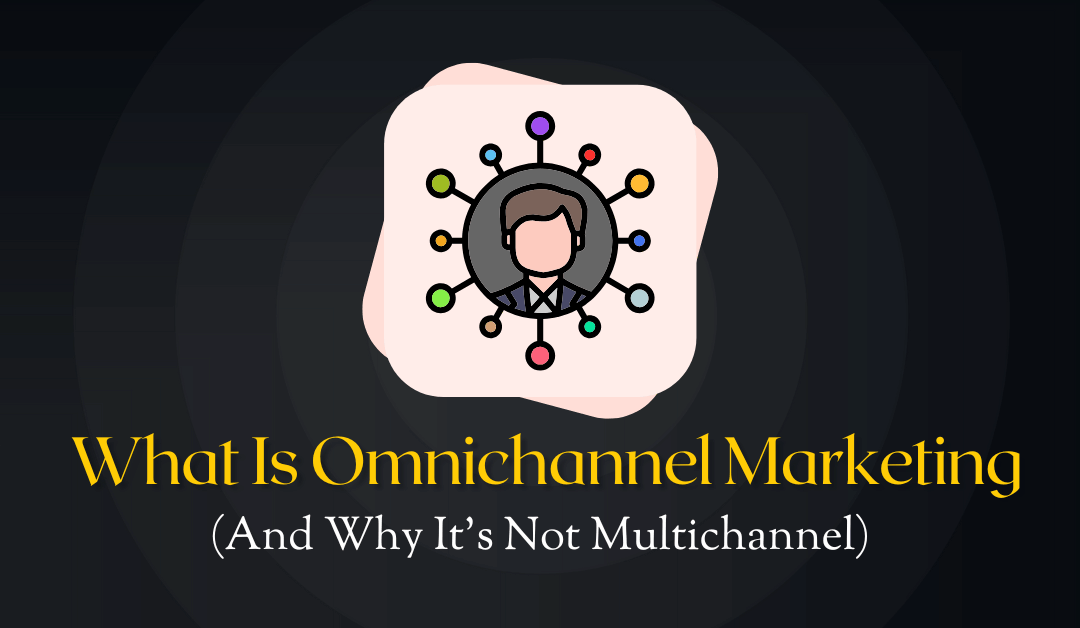What Is Omnichannel Marketing (And Why It’s Not Multichannel)
Have you ever added an item to your shopping cart on a mobile app, gotten distracted, and later received an email on your laptop reminding you about it? That’s Omnichannel Marketing in action.
It’s a marketing strategy that focuses on creating a single, seamless, and continuous experience for your customer across every single touchpoint. Whether they are on your website, in your physical store, browsing social media, or opening an email, the experience is integrated. All your channels “talk to each other” to understand where the customer is in their journey.
This is often confused with multichannel marketing. The difference is simple but crucial:
- Multichannel: Your brand is on multiple channels (e.g., Facebook, email, a physical store). However, these channels operate in silos. They don’t share data or connect the customer’s experience.
- Omnichannel: Your brand is on multiple channels, but they are all connected. The customer’s journey is seamless, allowing them to hop from one channel to another without friction. Their cart, profile, and support history follow them.
Why You Need a Winning Omnichannel Marketing Strategy
In today’s world, customers don’t see channels; they see one brand. They expect a consistent experience everywhere. Failing to provide this leads to frustration and lost sales. A smart Omnichannel Marketing strategy is no longer a “nice to have”—it’s essential for growth.
Here’s why it’s so powerful:
- Sky-High Customer Loyalty: When you provide a seamless, personalized experience that makes a customer’s life easier, they have no reason to look elsewhere. It builds trust and massive brand loyalty.
- Increased Revenue: It’s a proven fact. Studies have shown that companies with strong omnichannel strategies have significantly higher customer retention and purchase rates. One report from Omnisend found that marketers using three or more channels in a campaign earned a 287% higher purchase rate than those using a single channel.
- Better Customer Data: By integrating your channels, you gather a complete 360-degree view of your customer. You see how they browse, what they buy, and where they drop off, allowing you to personalize your marketing with incredible accuracy.
- Stronger Brand Recognition: A consistent message, tone, and visual identity across all platforms make your brand instantly recognizable and appear more professional and reliable.
How to Build Your Winning Strategy in 4 Steps
Building a true Omnichannel Marketing framework takes effort, but you can start with these four foundational steps.
1. Map Your Customer Journey
You can’t create a seamless journey if you don’t know what it looks like. Start by mapping out all the potential touchpoints your customers have with your brand, from initial awareness (like seeing a social media ad) to purchase (your website) and post-purchase (customer support). Identify their pain points and where friction occurs.
2. Centralize Your Data
This is the technical core. Your data from all these touchpoints—website analytics, CRM, point-of-sale (POS) system, email platform, and social media—needs to live in one place. A Customer Data Platform (CDP) is often the best tool for this, as it creates a single, unified profile for each customer that all your other tools can access.
3. Integrate Your Tech and Teams
With your data centralized, you must ensure your technology is integrated. Your e-commerce platform should talk to your inventory system. Your email marketing tool should be triggered by website behavior. Just as importantly, your teams must be integrated. Your marketing, sales, and customer service departments can no longer work in silos. They must share data and work toward the same goal: a seamless customer experience.
4. Create and Follow Clear Brand Guidelines
To ensure your brand feels the same everywhere, you need strong brand guidelines. This document should cover everything from your logo and color palette to your brand’s tone of voice. Whether a customer is reading a tweet or talking to a chatbot, the interaction should feel like it’s coming from the same brand.
Real-World Examples of Omnichannel Marketing
To see how powerful this is, look at these common examples:
- Starbucks: The Starbucks Rewards app is a masterclass. You can check your balance on your phone, pay with the app in-store, get a reward, and then see that reward reflected on your email or desktop account. It’s all one system.
- “Click and Collect” (BOPIS): Any retailer that lets you “Buy Online, Pick Up In-Store” is using an Omnichannel Marketing strategy. They are connecting their e-commerce inventory with their physical store’s inventory, allowing the customer to choose the most convenient fulfillment method.
- The Abandoned Cart Journey: A customer adds shoes to their cart on your website but doesn’t buy.
- Two hours later: They get a gentle reminder email.
- The next day: They see an ad on Instagram for those exact shoes.
- Two days later: They receive an SMS with a 10% discount code to complete their purchase.
This journey is targeted, helpful, and moves the customer toward a purchase without being disjointed.
Conclusion: Start Your Omnichannel Journey
Ultimately, Omnichannel Marketing is about putting the customer, not your channels, at the center of your strategy. It’s a shift from “How do we sell on Facebook?” to “How does our customer use Facebook, and how can we make their experience there connect to our website and our app?”
By understanding your customer’s journey, unifying your data, and keeping your brand message consistent, you can build a powerful, seamless experience that wins customers for life.

